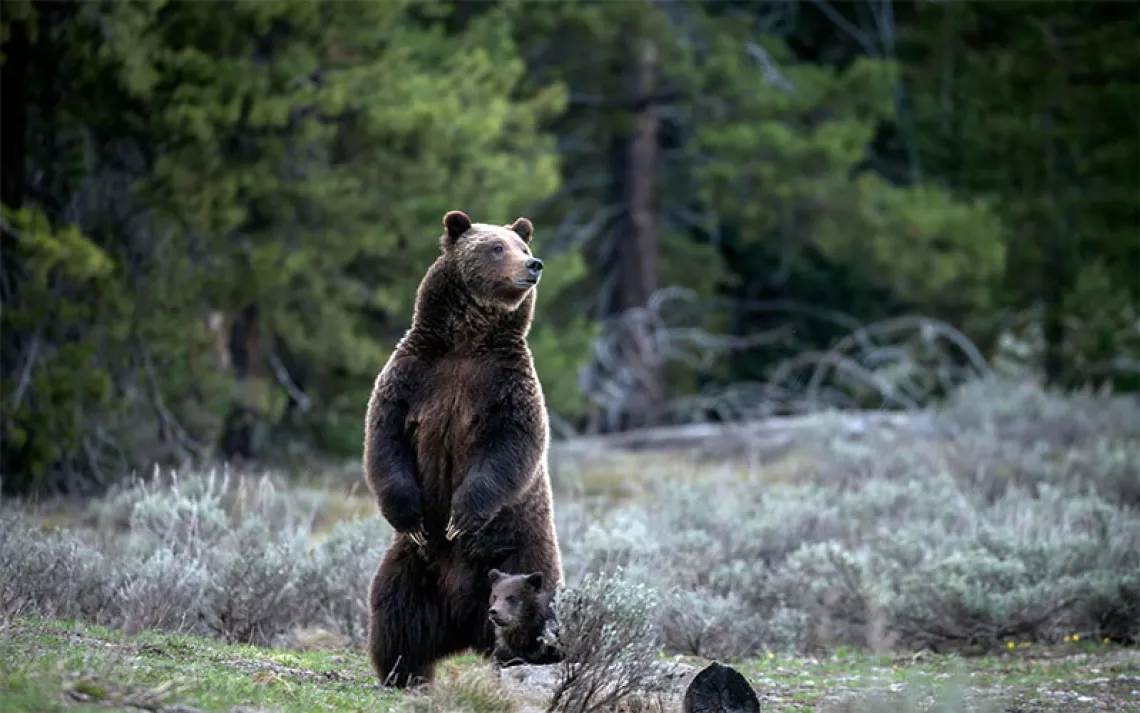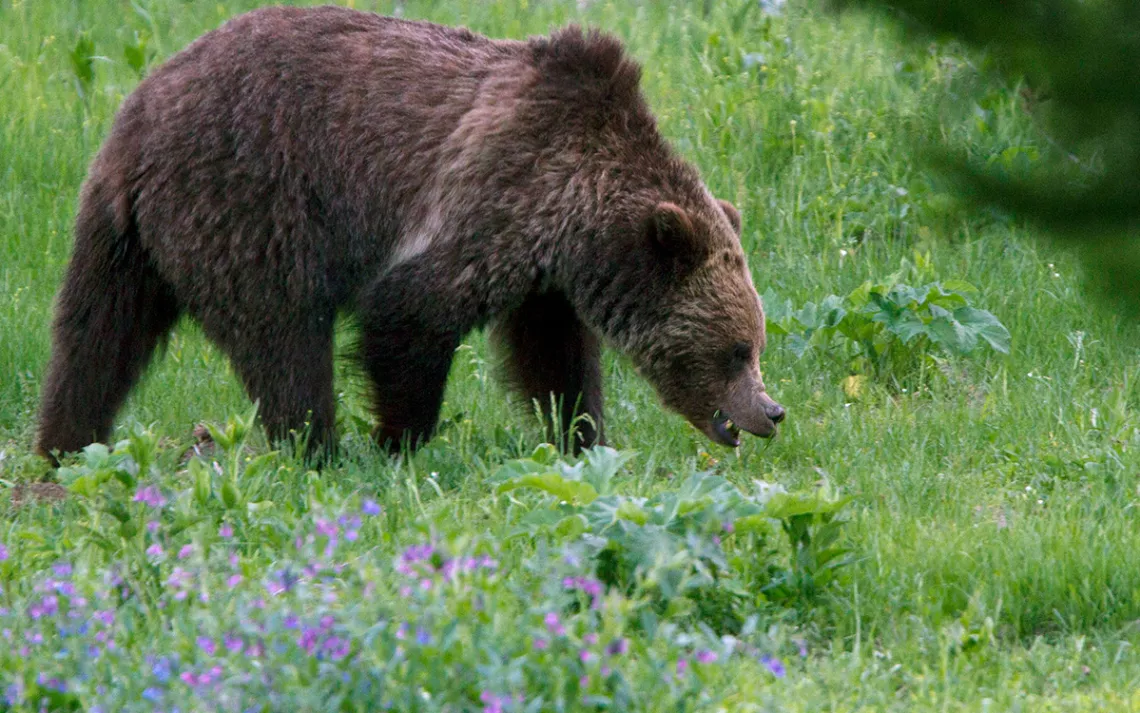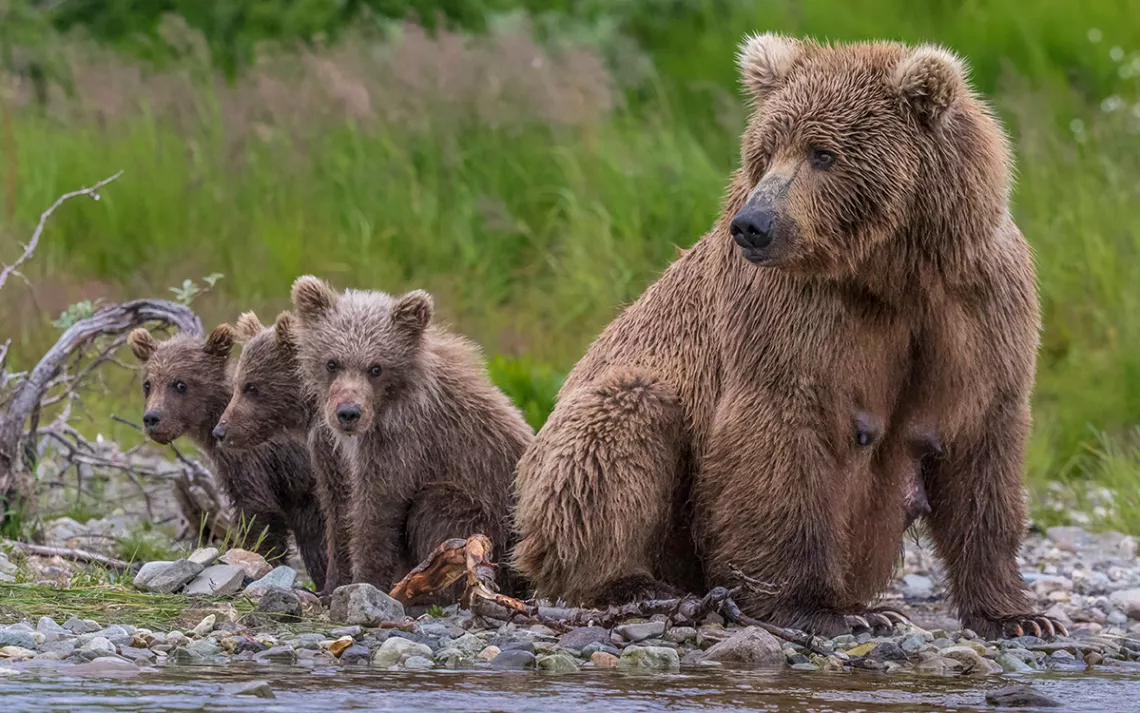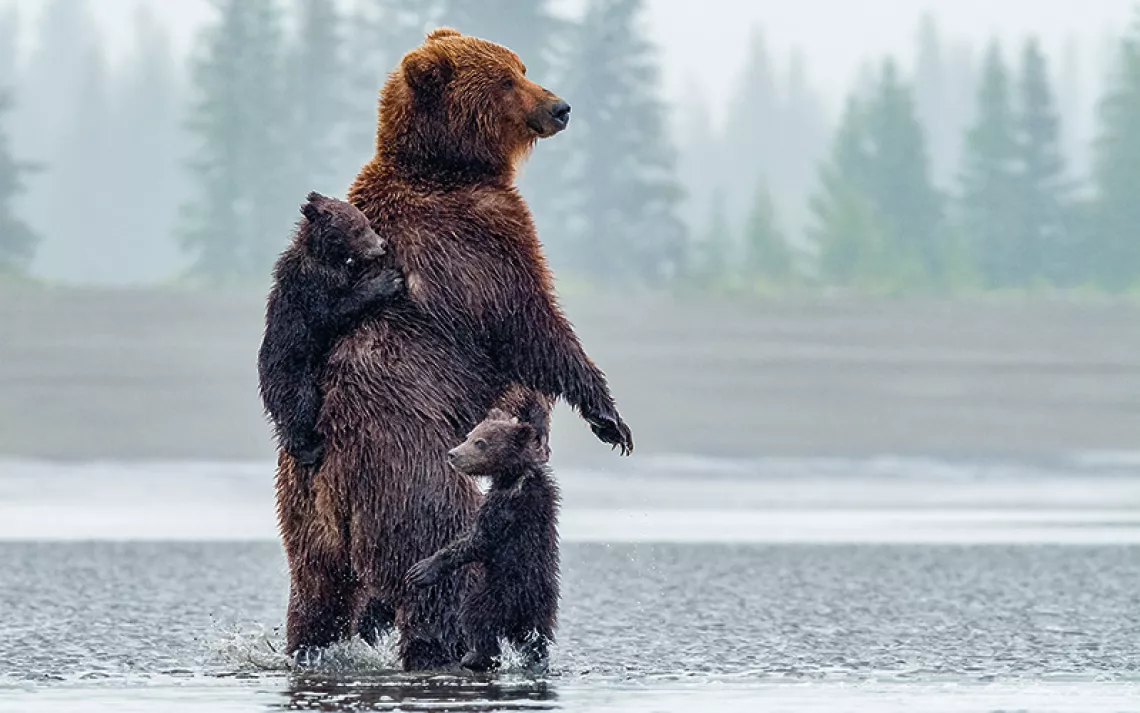Grizzly Bears Saved
The Biden administration secures the short-term future for grizzlies in the northern Rockies
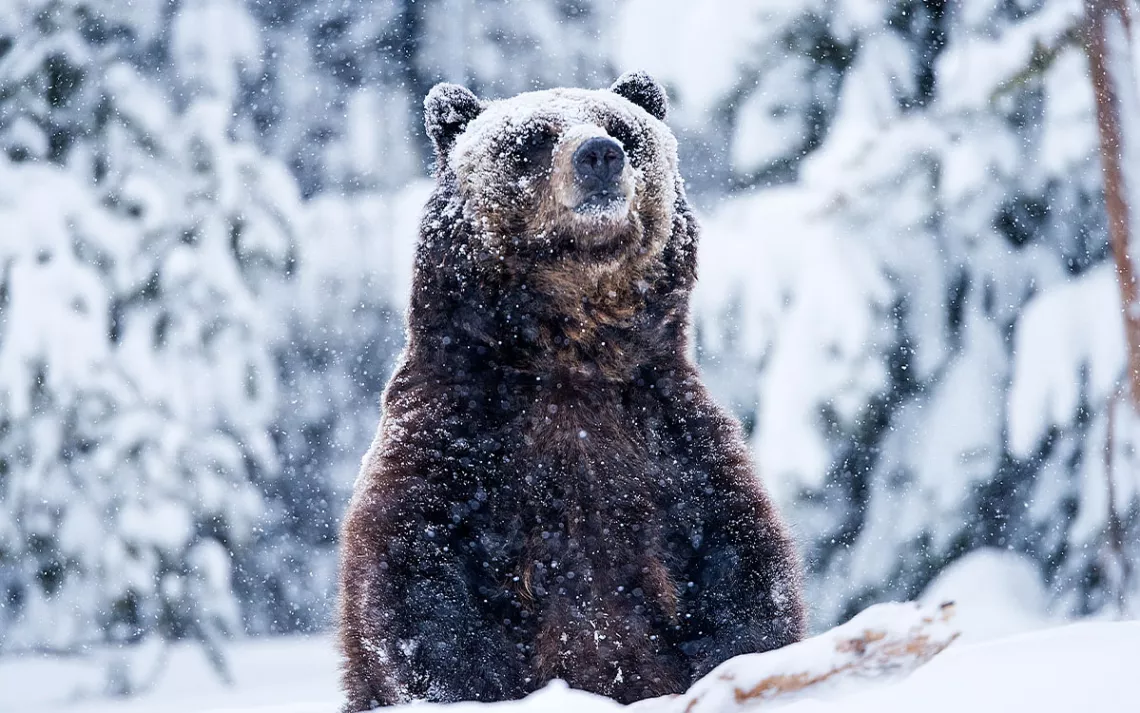
Photo by Mark Newman/Getty Images
Grizzly bears remain protected—for now. In what is likely President Biden’s last major wildlife decision, his administration announced on Tuesday that it would keep grizzlies listed as threatened under the Endangered Species Act. The bears have not returned to 96 percent of their historic range, which includes five recovery areas across Montana, Wyoming, Idaho, and Washington State—a fact that was crucial to the US Fish and Wildlife Service (USFWS) decision.
In addition to keeping the bears listed, the agency denied state requests to create separate Distinct Population Segments, which would have divided the region’s bears into different recovery groups. Instead, the agency created one single Distinct Population Segment, which combines the populations of grizzlies spread throughout the Northern Rockies. Lastly, federal wildlife managers amended an ESA provision, called the 4(d) rule, that grants states more autonomy in managing bears, such as allowing states and landowners the ability to use lethal measures to deter bears from livestock or personal property.
“This reclassification will facilitate recovery of grizzly bears and provide a stronger foundation for eventual delisting,” Martha Williams, the USFWS director, said in a statement. “And the proposed changes to our 4(d) rule will provide management agencies and landowners more tools and flexibility to deal with human-bear conflicts, an essential part of grizzly bear recovery.”
The decision comes roughly three years after governors from Wyoming and Montana submitted petitions to remove grizzlies from the ESA, which would return management to the states. With approximately 1,700 bears across the Yellowstone National Park and Glacier National Park ecosystems, state leaders argue that grizzlies have met recovery goals in these areas. These numbers are based on the Grizzly Bear Recovery Program assessment, which says there should be at least 500 bears throughout the Greater Yellowstone Ecosystem and at least 800 in the Northern Continental Divide Ecosystem, abutting Montana’s Canadian border.
In its new analysis, the USFWS took the view of independent scientists and conservation advocates who say that recovery is about much more than numbers. It's not just a numerical calculation; it's also about bears fulfilling an ecological role in larger ecosystems, where populations are connected, and there are opportunities for genetic exchange. Consequently, conservation groups have largely hailed the ruling as a success.
“We applaud the Fish and Wildlife Service for following the science and keeping grizzly bears protected," Drew Caputo, Earthjustice's vice president of litigation for lands, wildlife, and oceans, said in a statement. "The best-available science shows that grizzly bears are not recovered and the states have a demonstrated record of failing to manage grizzly bears responsibly.”
Why grizzly recovery is important
The recovery of grizzly bears in the lower 48 states has been slow and unsteady. The population has gone from several hundred in the 1970s to about 2,000 today. That may sound like a lot, but adding a few hundred individuals over a 50-year period means that the bears are struggling to find a foothold. An uptick in deaths due to disease and overhunting could set back recovery efforts by decades.
One reason for the slow population growth is that grizzlies face a gauntlet of threats. Chief among them, said Christopher Servheen, a former USFWS grizzly bear biologist, are conflicts with people. According to the Interagency Grizzly Bear Committee, 85 percent of grizzly deaths are caused by people, through poaching or unintentionally killing bears. Last year was one of the deadliest years for grizzlies, with at least 90 human-caused bear fatalities, including the most famous grizzly in the world, who was struck and killed by a car outside of Yellowstone National Park.
In addition to fulfilling a moral duty to restore an iconic predator, conservationists see grizzly restoration as a win for other species lower on the food chain. Due to their need for large areas, grizzlies are an umbrella species, meaning their expansive habitat usually protects other species. They’re also a keystone species that keeps ecosystems in check through predation, which keeps grazing herbivores, like elk, on the move.
Grizzlies are also special to Indigenous peoples, who often center them in their histories, traditions, and ceremonies. In 2016, a coalition of 170 tribes from the US and Canada formed The Grizzly: A Treaty of Cooperation, Cultural Revitalization, and Restoration. At the time, tribal leaders were responding to the Trump administration's efforts to delist the bears from the ESA. Instead of completely delisting bears and handing management over to the states, the tribes suggested a comanagement strategy that would include traditional ecological knowledge.
“Some projections show that the grizzly in the North could be on the verge of extinction in as few as 50 years,” said Chief Stanley Grier, chief of the Piikani Nation and president of the Blackfoot Confederacy Chiefs. “The Crown of the Continent is the heartland of the Blackfoot Confederacy, and we will not stand by and watch our ancestors’ legacy pass into oblivion with the sacred grizzly bear.”
The future for grizzlies
The USFWS considered five metrics to assess the status of grizzly bears—quality of habitat, human-caused mortality, disease, adequacy of conservation laws, and natural threats. Conservation groups say that states have failed to address many of these issues. One of them, in particular—regulatory mechanisms to ensure a species doesn’t approach extinction—has proved challenging to sort out. In their management plans, Montana, Idaho, and Wyoming have taken a view of recovery that creates de facto open zoos, where bears are moored in and around national parks without much room to roam. Hunting and trapping, which would be expanded under state management, would cut off any chance of bears naturally dispersing or connecting with other populations.
“We look forward to working with the incoming Trump administration to explore a new path forward,” Greg Gianforte, Montana’s Republican governor, said in an Instagram post following the announcement. “Together, we will return the management of the grizzly bears to the state of Montana and protect our Montana way of life.”
Meanwhile, conservation groups and researchers hope that the USFWS will develop a new management plan for grizzlies, which could take years to finalize. The most recent plan is 30 years old. A chief proponent of a revamp is the original plan’s author, Chris Servheen. According to him and 15 conservation groups, the agency should do more to protect grizzly habitat from sprawl and bolster measures to prevent conflicts with people. In addition, Servheen says that states should commit to advancing laws that protect bears before federal protections are removed.
In September, allies of Donald Trump directed the incoming president to remove grizzlies from the ESA completely. His administration will likely attempt to deliver on that promise, but it will take time, say close watchers of the effort, which would offer the bears somewhat of a buffer. The USFWS will need to start the years-long delisting process all over again, and it’ll have to show why it is changing course. Governors in Western states could also resubmit delisting petitions, but that would entail a completely new 12-month finding.
“When there's really strong science … it’s really hard for [a new administration] to make a legal argument that suddenly, a year or two later, grizzlies are in a completely different place,” said Bradley Williams, the deputy legislative director for the Sierra Club’s Wildlife and Lands Protection program. “On the congressional side, it’s great because denial of petitions cannot be undone through the CRA (Congressional Review Act) process.”
What Congress can do is attempt to delist grizzlies through legislation. The current Congress has introduced at least half a dozen bills that would partially delist grizzlies in some parts of the lower 48 states. Still, if delisting does occur, the ESA requires the federal government to monitor bear recovery for at least five years, and the agency would manage the species on federal lands. The continuing role of the federal government means that calls to bolster a federal management plan would be useful no matter the status of the species.
In the following weeks, the agency plans to hold a series of public meetings in Montana, Idaho, and Wyoming to invite local stakeholders to provide feedback. Once the agency publishes its decision in the Federal Register, a comment period will open up when the public can weigh in.
“Grizzly presence is part of what makes this part of America so special, Servheen said in his report. “We should choose a careful management approach that will assure the future for these magnificent animals because they are an important part of the heritage of the American West.”
 The Magazine of The Sierra Club
The Magazine of The Sierra Club
